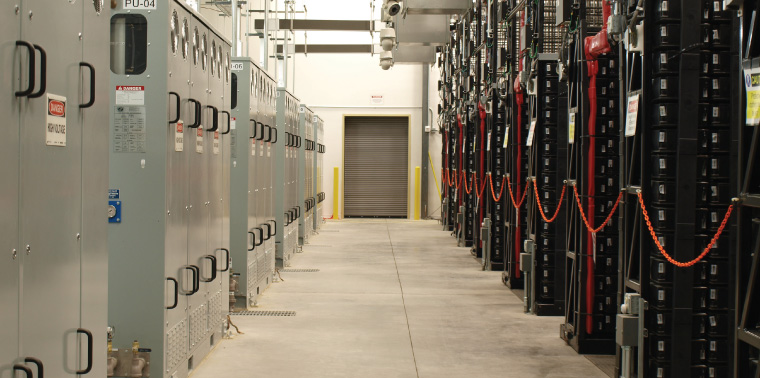March 1, 2013 — Largely out of sight, tucked into building basements and stashed in garages, a new generation of energy storage technology is poised to help our aging grid not only avoid outages, but enable vast new flows of renewable power, all while saving some serious money. Call it the smart storage revolution.
California is ground zero for this trend. Across the Golden State, costs for electric power are high, renewables are multiplying, and key grid links are overloaded. But rather than rely on longstanding industry practice to fix grid problems by building more power plants or transmission lines, California regulators are encouraging customers and utilities to innovate.
At two InterContinental Hotels in the Bay Area, new storage technology is helping to reconcile these many challenges. The hotels’ secret weapon is a pair of fridge-sized boxes loaded with lithium-ion (Li-ion) batteries. Day to day, they’re able to cut the hotels’ electricity costs by up to 15 percent.
They do so by taking advantage of California’s complex power pricing regime. Smart software recharges the batteries when power is cheap, typically at night. When rates head up, the system seamlessly switches part or all of the hotels’ load to the batteries, thereby avoiding the need to purchase power at the costliest times, explains Salim Khan, CEO of Stem, the Millbrae, Calif.–based startup that built the systems.

New storage technology at two InterContinental Hotels in the Bay Area cuts the hotels’ electricity costs. Photo courtesy of Stem.
The technology helps the broader grid, too, by reducing the risk of outages. Grid gurus call it “peak shaving.” It’s a nifty trick in which stored energy displaces active generation during key moments. On the hottest days, even a tiny sliver of this kind of savings can make the difference between a blackout and business as usual.
For now, the InterContinental Hotels’ storage units are an exception, but they’re set to become a rule. In February, California became the first state to order investment in smart grid storage, initially calling for 50 megawatts (MW) in the Los Angeles basin area.
The rule doesn’t detail what kind of storage to deploy. Rather, it aims to spark more market innovations, like Stem’s, that improve grid performance while saving money. “This is a huge signal to the market that storage is ready to play” on par with conventional power plants, says Janice Lin, executive director of the California Energy Storage Alliance.
Goldilocks Storage
To be sure, storing electricity isn’t anything new. Cell phones, e-readers and laptops, all integral to daily life, let us use a little of the grid’s generation on the go.
Storage is well established at the macro scale, too. A little-known backbone of the U.S. grid is more than 20,000 MW — equal to the capacity of some 22 nuclear power plants — of “pumped hydro” storage. Scattered at scores of remote sites around the U.S., these systems comprise some 99 percent of today’s storage capacity.
At night, utilities use low-cost energy to pump water from a lower reservoir uphill to a higher basin. The next day, as demand peaks, the water is sent back downhill to generate power. Think of pumped hydro as the biggest battery we have. It’s capable of delivering city-sized volumes of power for hours in a row. That’s why grid operators are pushing to install thousands more megawatts of capacity.
But, as California is finding, on today’s grid, the sweet spot for smart storage is at scales somewhere between these two extremes. Much bigger than handheld phone batteries, but smaller than gargantuan lakes of hydropower, smarter storage solutions can be an ideal fit for critical niches where a midsize dollop of power, supplied for minutes or hours, is all that’s needed.
Sharing California’s Problems
California’s problems aren’t unique. Similar problems are surfacing across the U.S.
Transmission constraints. L.A.’s biggest problem isn’t inadequate supply of power — most of the time there’s enough juice available from regional generators. The real problem is funneling all that power through aged transmission lines that can’t handle the load.
In most markets installing new transmission cables, or even upgrading existing lines, is a no-go. As populations have grown, the cost of new grid links has skyrocketed; likewise, public patience with big construction projects is scant. New York City and Long Island face similar transmission constraints.
Storage offers a tidy solution. At night, utilities can use existing transmission lines to fill up batteries positioned near demand hot spots. Later, if demand peaks beyond power lines’ ability, batteries can fill in the necessary excess. “Energy storage helps you do more with less infrastructure,” says Bill Acker, executive director of NY-BEST, an energy storage technology consortium based in Albany, N.Y.
Ensia shares solutions-focused stories free of charge through our online magazine and partner media. That means audiences around the world have ready access to stories that can — and do — help them shape a better future. If you value our work, please show your support today.
Yes, I'll support Ensia!

It purely talks about $ per kWh. However the reference used to back up "could be on track to decline by another 50 percent by 2020, to $300 to $600 per kWh" is in fact to a site that talks about storage dropping to $300 to $600 per kW, not kWh.
The website linked to also gives the costs in Australian, not US dollars.
Before making optimistic prognostications about costs reductions in battery storage it may be best to check that the numbers stack up first.
Robert Wilson
http://carboncounter.wordpress.com/
"California isn’t facing an imminent energy crisis, nor would renewables be to blame if such a thing occurred. What California is really facing is the need to add flexible capacity to its energy supply mix."
You say, "as a rule of thumb, grid experts believe that when intermittent power sources such as wind and solar surpass 20 percent, grid instability soars." However, DOE studies such as the Western Wind and Solar Integration Study have found that this is not the case. Even for renewable penetrations in excess of 30%, they did not find a need for storage. It was not even cost-justified to build more pumped hydro.
There will certainly be localized situations where storage will first be cost effective, such as the peak shaving opportunities that you discuss in the article or to help put more distributed solar energy on weak distribution feeders, but I don't see evidence that large-scale storage will play a major role (or be required) for higher penetrations of renewables in the general case.
I agree with the comment that you posted above about California - they need flexibility in their system. But it is interesting to note that well functioning power markets like ERCOT in Texas and MISO in the Midwest, where they dispatch wind energy and almost all conventional generators participate in the market, do not have the same concern as California. For complex reasons, most conventional generators in California do not allow the market system to dispatch their units, so even the flexibility that exists is often not available to the system operator. Hopefully they will find ways to fix that as well as add more flexible capacity.
While IA and SD are small demand pools, these records reinforce the point that grid operators, especially in the wind-rich Midwest and Texas (n.b.: Texas has more installed wind capacity than the U.K.), are fast learning to better manage big volumes of variable renewables. As this post at World Resources Institute explains, more states are headed towards this threshold, too: wind topped 10 percent for the full year in seven other states (North Dakota, Minnesota, Kansas, Colorado, Idaho, Oklahoma, Oregon).
You raise a good point about the deep role of regulations here. They are vexingly complex within each market, and vary from region to region. I’ve heard industry players repeatedly point out that many of the technical regulatory rules governing the grid were set out decades ago, meant to ensure stability at all costs, but today have the unintended effect of locking out newer technologies.
In a negative example, grid rules here in the NY region — and many others, I understand — meant that owners of solar-powered houses were surprised to discover they couldn’t tap their own panels when the wider grid went down after Superstorm Sandy. But change is afoot, if slowly. In a good example, federal grid rules were recently revised to reward providers of a type of very short term grid storage (known as frequency regulation) in such a way that advanced flywheels are winning-out over incumbent fossil fuel plants.
The addition of storage is a facet of the larger, long-term rehab of our aging grid. And however quickly storage scales up, we need to continue to upgrade the hardware and software that manages the grid. A smarter grid opens the door to much larger flows of renewables, while also lowering the risk of blackouts.